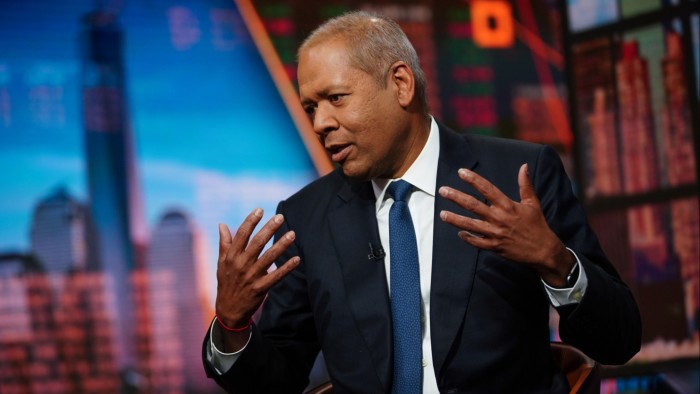Unlock the Editor’s Digest for free
Roula Khalaf, Editor of the FT, selects her favourite stories in this weekly newsletter.
It is fair to assume that, had any of the last few chief executives of Barclays bank been asked to sign a letter urging the government to rescind punitive regulations, they’d have jumped at the chance.
From John Varley, who ran Barclays during the 2008 financial crisis, to Jes Staley, CEO up to three-and-a-bit years ago, the bank’s bosses have consistently campaigned to resist government bailouts and fend off onerous regulations.
Not Venkat, as he is universally known. CS Venkatakrishnan, Barclays’ boss since late 2021, last week went public in support of so-called ringfencing, one of the onerous post-2008 rules forcing big complex banks to structurally protect their core UK deposit-taking operations inside separate legal entities with higher levels of capital.
Arguing that he was “on the side of depositor protection”, Venkat recalled that it was not long since banks had to be bailed out by the state. Ringfencing should not be scrapped or watered down, he said.
A few days earlier the Barclays boss had declined to sign a letter to UK chancellor Rachel Reeves from other top bank CEOs, taking the polar opposite line. That letter, orchestrated by HSBC boss Georges Elhedery, had urged Reeves to prove “the government’s determination to do what it takes to promote growth” and pledge at her July Mansion House speech that ringfencing would be abolished during the current parliament.
Cue dissent across the City of London (including within Barclays itself), plus a mystery as to why the bank that has probably lost the most from ringfencing’s restrictions, thanks to its large investment banking and US credit card operations, would want to maintain such curbs.
Like HSBC, Barclays is said by bank insiders to have spent at least £1bn implementing ringfencing. The rules impose ongoing costs, such as duplicate operations and governance overheads, and create inefficiencies by restricting how funds can be deployed within the broader group. So why has Barclays gone out on a limb, apparently against its own self-interest?
Venkat’s public reasoning — a desire to protect depositors — sounds noble but strikes an odd note: surely a bank CEO should be confident he can be a trusted guardian of customer money, without the need for a state diktat. Perhaps his prior career at Barclays — first as chief risk officer, then as head of markets — has made him distrustful that his investment bankers won’t misuse retail deposits. A hard rule is a helpful strut.
Pragmatism also plays a part. In addition to the sunk cost of implementation, Venkat has built a whole strategy for Barclays that aligns with the ringfenced structure, doubling down on UK retail banking and curtailing growth in its global investment banking operations. Taking a pro-regulation line may also curry further favour with policymakers who generally dislike being publicly lobbied. (Venkat broke with much of the business world last autumn when he praised Reeves’ widely criticised tax-raising Budget.)
The calculus for the chancellor is a tricky one. Ringfencing probably has held back Britain’s banks, particularly internationally, but it is fanciful to think the rule is to blame for their failure to keep pace with Wall Street rivals: a weaker domestic economy, the trauma of 2008 (particularly at NatWest/RBS and Barclays) and tougher regulations in other areas have been far more impactful.
Advocates of reform also posit that ringfencing is now superfluous: since it was introduced, other safety mechanisms — requirements for capital, liquidity and orderly wind-down in a crisis — have been significantly toughened: you don’t need a belt and braces if your waistband is already tight.
Few other countries have adopted a similar construct. Switzerland is one, though its 2023 decision to force the failing Credit Suisse into a rescue by UBS, rather than save the ringfenced domestic operation and wind down the rest of the group, did nothing to prove the effectiveness of such a mechanism.
As with any deregulatory measure, Reeves will have to offset growth benefits against the downsides of losing a safety mechanism — particularly for consumers aka voters. Aside from boosting the security of deposits (beyond the sector-wide £85,000 guarantee), bankers believe ringfencing has kept mortgage rates artificially low. Once UK funding is no longer trapped, rates could rise. “Removing ringfencing would be foolish policy and odd politics,” says Sir John Vickers, the Oxford academic who led the regulatory commission that conceived the rules.
Even if Reeves concludes that the Elhedery camp is right, and Venkat is wrong, it would take a long time — and new primary legislation — to revoke ringfencing. A quick spur for growth it certainly isn’t.
